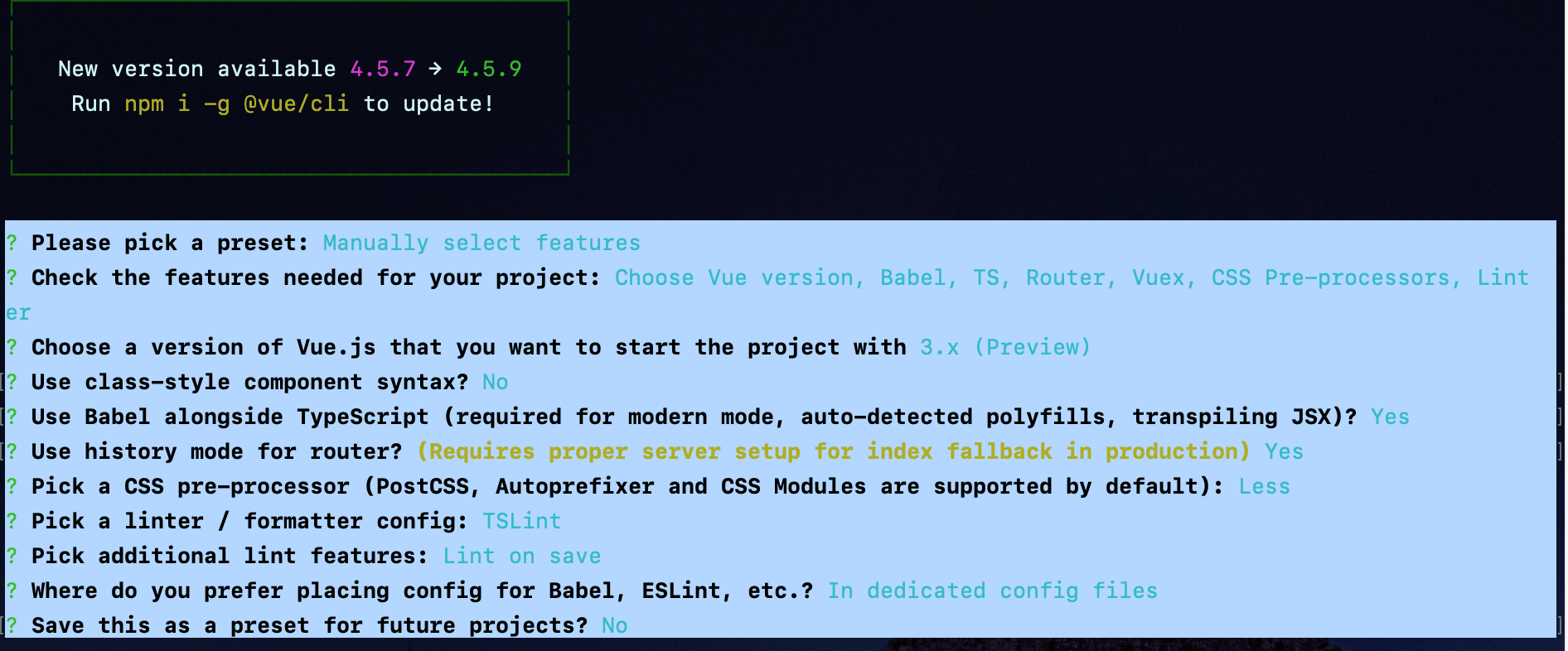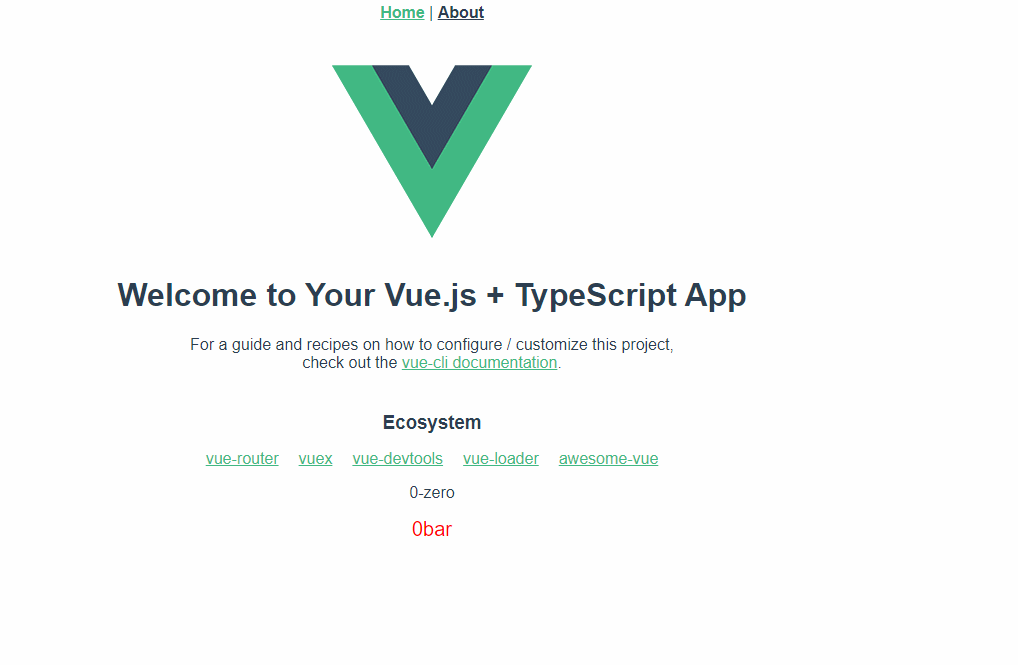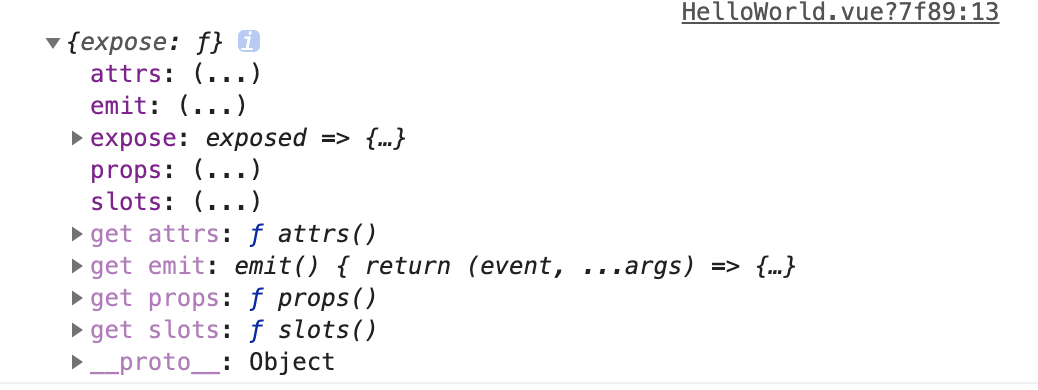Vue3 one piece 前言 Vue3发布有一段时间啦,也一直在关注Vue3带来的新特性,也在看不少业界大佬分享的一些文章。时逢元旦,正所谓“新年新气象”,新的一年,我也决定系统的学习一下新版本的Vue——Vue3。本文打算主要学习一下Vue3的主要的新特性—— Composition API 。
讲真的,我超喜欢one piece这个版本名字。
初始化项目
安装vue-cli
1 2 3 npm install -g @vue/cli # OR yarn global add @vue/cli
创建项目
配置如下
setup setup函数是一个新的组件选项 ,作为在组件内使用 Composition API 的入口点。
所谓组件选项即 诸如:data, methods, directives, watch, computed, mounted, props, name, filters(3.0已删除)等等~~
1 2 3 4 5 6 7 8 9 10 11 12 13 14 15 16 17 18 19 20 21 22 23 24 25 26 27 28 29 30 31 32 33 /* Home.vue */ <template > <div class ="home" > <img alt ="Vue logo" src ="../assets/logo.png" > <HelloWorld msg ="Welcome to Your Vue.js + TypeScript App" /> <p > {{count}}-{{foo.bar}} </p > </div > </template > <script lang ="ts" > import { defineComponent, reactive, ref } from 'vue' ; import HelloWorld from '@/components/HelloWorld.vue' ; export default defineComponent ({ name : 'Home' , components : { HelloWorld , }, setup ( const count = ref (0 ); const foo = reactive ({ bar : 'zero' }) return { count, foo } } }); </script >
注意setup返回的ref在模板中会自动解开,不 需要写.value。
setup也可以返回一个函数,函数中也能使用当前作用域中的响应式数据:
新建了一个render.vue
里面用到的渲染函数的部分写法与vue2.x有些不同,后续会总结
1 2 3 4 5 6 7 8 9 10 11 12 13 14 15 16 17 18 19 20 21 22 23 24 25 26 27 28 /* render.vue */ <script lang ="ts" > import { h, reactive, ref } from "vue" ;interface Object { foo : string | number; } export default { setup ( const count = ref (0 ); const object : Object = reactive ({ foo : "bar" , }); const plusOne = (): void => count.value ++; } return () => h ('div' , { style : { color : 'red' , fontSize : '20px' , }, onClick : plusOne, id : 'renderCom' }, [count.value , object.foo ]) }, }; </script >
在Home.vue中引入
1 2 3 4 5 6 7 8 9 10 11 12 13 14 15 16 17 18 19 20 21 22 23 24 25 26 27 28 29 30 31 32 33 34 <template> <div class="home"> <img alt="Vue logo" src="../assets/logo.png"> <HelloWorld msg="Welcome to Your Vue.js + TypeScript App"/> <p> {{count}}-{{foo.bar}} </p> + <render /> </div> </template> <script lang="ts"> import { defineComponent, reactive, ref } from 'vue'; import HelloWorld from '@/components/HelloWorld.vue'; // @ is an alias to /src + import render from '@/components/render.vue'; export default defineComponent({ name: 'Home', components: { HelloWorld, + render }, setup() { const count = ref(0); const foo = reactive({ bar: 'zero' }) return { count, foo } } }); </script>
该函数接受props作为其第一个参数:
1 2 3 4 5 6 7 8 9 10 11 12 13 14 15 16 17 18 19 /* HelloWorld.vue */ ... <script lang ="ts" > import { defineComponent, onMounted, watchEffect } from 'vue' ;export default defineComponent ({ name : 'HelloWorld' , props : { msg : String , }, setup (props ) { onMounted (() => { console .log ('mounted hook trriger' ); console .log (props.msg ); }) } }); </script > ...
注意:props对象是响应式的,watchEffect或watch会观察和响应props的更新。
1 2 3 4 5 6 7 8 9 10 11 12 13 14 15 16 17 18 19 20 21 22 23 /* HelloWorld.vue */ ... <script lang="ts"> import { defineComponent, onMounted, watchEffect } from 'vue'; export default defineComponent({ name: 'HelloWorld', props: { msg: String, }, setup(props) { onMounted(() => { console.log('mounted hook trriger'); console.log(props.msg); }) + watchEffect(() => { + console.log(`msg is ${props.msg}`) + }) } }); </script> ...
同时在Home.vue中改变传入HelloWorld.vue的msg值:
1 2 3 4 5 6 7 8 9 10 11 12 13 14 15 16 17 18 19 20 21 22 23 24 25 26 27 28 29 30 31 32 33 34 35 36 37 38 39 <template > <div class ="home" > <img alt ="Vue logo" src ="../assets/logo.png" > <HelloWorld @click ="reverse" :msg ="msg" /> <p > {{count}}-{{foo.bar}} </p > <render /> </div > </template > <script lang ="ts" > import { defineComponent, reactive, ref } from 'vue' ;import HelloWorld from '@/components/HelloWorld.vue' ; import render from '@/components/render.vue' ;export default defineComponent ({ name : 'Home' , components : { HelloWorld , render }, setup ( const count = ref (0 ); const foo = reactive ({ bar : 'zero' }); const msg = ref ('Welcome to Your Vue.js + TypeScript App' ); const reverse = (): void => msg.value = msg.value .split ('' ).reverse ().join ('' ); } return { count, foo, reverse } } }); </script >
然而不要 解构props对象,那样会使其失去响应性:
1 2 3 4 5 6 7 8 9 10 11 12 13 14 15 16 17 18 19 20 21 22 23 /* HelloWorld.vue */ ... <script lang ="ts" > import { defineComponent, onMounted, watchEffect } from 'vue' ;export default defineComponent ({ name : 'HelloWorld' , props : { msg : String , }, setup ({ msg } ) { onMounted (() => { console .log ('mounted hook trriger' ); console .log (msg); }) watchEffect (() => { console .log (`msg is ${msg} ` ) }) } }); </script > ...
在开发过程中,props 对象对用户空间代码是不可变 的(用户代码尝试修改 props 时会触发警告)。
第二个参数提供了一个上下文对象,从原来2.x中this选择性地暴露了一些property。
1 2 3 4 5 6 7 8 9 10 11 12 13 14 15 16 17 18 19 20 21 22 23 24 /* HelloWorld.vue */ ... <script lang ="ts" > import { defineComponent, onMounted, watchEffect } from 'vue' ;export default defineComponent ({ name : 'HelloWorld' , props : { msg : String , }, setup (props, ctx ) { onMounted (() => { console .log ('mounted hook trriger' ); console .log (props.msg ); console .log (ctx); }) watchEffect (() => { console .log (`msg is ${props.msg} ` ) }) } }); </script > ...
attrs和slots都是都是内部组件实例上对应项的代理(Proxy),可以确保在更新后仍然是最新值。所以可以解构,无需担心后面访问到过期的值:
1 2 3 4 5 6 7 8 9 10 11 12 13 14 15 16 17 ... export default defineComponent ({ name : 'HelloWorld' , props : { msg : String , }, setup (props, { attrs, slots } ) { onMounted (() => { console .log ('mounted hook trriger' ); console .log (props.msg ); console .log (attrs); console .log (slots); }) } }); ...
响应式系统API reactive 接受一个普通对象 然后返回该普通对象的响应式代理(Proxy) 。等同于2.x的Vue.observable()
1 2 3 4 ... const foo = reactive ({ bar : 'zero' });...
响应式转换是“深层的”:会影响对象内部所有嵌套的属性。基于 ES2015 的 Proxy 实现,返回的代理对象不等于原始对象。建议仅使用代理对象而避免依赖原始对象。
ref 接受一个参数值并返回 一个响应式且可改变的ref对象 。ref对象拥有一个指向内部值的单一属性.value。
1 2 3 4 5 const count = ref (0 );console .log (count.value ); count.value ++; console .log (count.value );
如果传入 ref 的是一个对象,将调用 reactive 方法进行深层响应转换。
当 ref 作为渲染上下文的属性返回(即在setup() 返回的对象中)并在模板中使用时,它会自动解套,无需在模板内额外书写 .value:
1 2 3 4 5 6 7 8 9 10 11 12 <template > <div > {{count}}</div > </template > <script > export default { setup ( return { count : ref (0 ) } } } </script >
当ref作为reactive对象的property被访问 或修改 时,也会自动解套value值,其行为类似普通属性。
1 2 3 4 5 6 7 8 9 10 11 12 13 14 15 16 17 18 19 20 21 22 23 24 25 26 27 28 29 30 31 32 33 34 35 36 37 38 39 40 41 42 43 44 45 46 47 48 49 50 51 /* Home.vue */ ... <script lang="ts"> import { defineComponent, reactive, ref } from "vue"; import HelloWorld from "@/components/HelloWorld.vue"; // @ is an alias to /src import render from "@/components/render.vue"; export default defineComponent({ name: "Home", components: { HelloWorld, render, }, setup() { const count = ref(0); + const age = ref(18); const msg = ref("Welcome to Your Vue.js + TypeScript App"); const foo = reactive({ bar: "zero", }); //如果传入 ref 的是一个对象,将调用 reactive 方法进行深层响应转换。 const obj = ref({ a: 3, }); const person = reactive({ name: "yan", + age, }); const handlerClick = (): void => { obj.value.a++; count.value += 3; + person.age++; }; const reverse = () => { msg.value = msg.value.split("").reverse().join(""); }; return { count, foo, msg, handlerClick, reverse, obj, person }; }, }); </script> ...
注意当嵌套在 reactive Object 中时,ref 才会解套。从 Array 或者 Map 等原生集合类中访问 ref 时,不会自动解套:
1 2 3 4 5 6 7 const arr = reactive ([ref (0 )]);console .log (arr[0 ].value );const map = reactive (new Map ([['foo' , ref (0 )]]))console .log (map.get ('foo' ).value );
有时我们可能需要为 ref 做一个较为复杂的类型标注。我们可以通过在调用 ref 时传递泛型参数来覆盖默认推导:
1 2 3 const foo = ref<string | number >('123' );foo.value = 123 ;
computed 传入一个getter函数,返回一个默认不可手动修改的ref对象 。
1 2 3 4 5 6 7 8 9 10 11 12 13 14 15 16 17 18 19 20 21 22 23 24 25 26 27 28 29 30 31 32 33 34 35 36 37 /* HelloWorld.vue */ <template> <div class="hello"> <h1>{{ msg }} && {{plusCount}}</h1> </div> ... </template> <script lang="ts"> import { computed, defineComponent, onMounted, ref, watchEffect } from "vue"; export default defineComponent({ name: 'HelloWorld', props: { msg: String, }, setup(props, ctx) { + const count = ref(0); + const plusCount = computed(() => count.value+1) onMounted(() => { console.log('mounted hook trriger'); console.log(props.msg); console.log(ctx); + setInterval(() => { + count.value++; + }, 1000) }) watchEffect(() => { console.log(`msg is ${props.msg}`) }) + return { + plusCount + } } }); </script>
或者传入一个拥有get和set函数的对象,创建一个可手动修改的计算状态 。
1 2 3 4 5 6 7 const count = ref (0 );const plusCount = computed ({ get : () => count.value + 1 , set : (val ) => { count.value = val - 1 ; } })
readonly 传入一个对象(响应式或普通)或 ref,返回一个原始对象的只读代理。一个只读的代理是“深层的”,对象内部任何嵌套的属性也都是只读的。
1 2 3 4 5 6 7 8 9 10 11 12 13 14 15 16 17 18 19 20 21 22 23 24 25 26 27 28 29 30 31 32 33 34 35 36 37 38 /* HelloWorld.vue */ <script lang="ts"> import { computed, defineComponent, onMounted, reactive, readonly, ref, watchEffect } from "vue"; export default defineComponent({ name: "HelloWorld", props: { msg: String, }, setup(props, ctx) { const count = ref(0); const plusCount = computed(() => count.value+1) + const origin = reactive({ + countStart: 0 + }) const copy = readonly(origin); onMounted(() => { console.log("mounted hook trriger"); console.log(props.msg); console.log(ctx); setInterval(() => { - count.value++; + origin.countStart++ }, 1000) }); watchEffect(() => { console.log(`msg is ${props.msg}`); }); + watchEffect(() => { + console.log(`copy.countStart: ${copy.countStart}`); + }) return { plusCount } }, }); </script>
如果尝试修改只读属性:copy.value++, 此行为会被阻止并且抛出警告。
watchEffect 立即执行一个传入函数,并响应式追踪其依赖,并在其依赖变更时重新运行该函数。
参考上面代码:point_up_2:
停止侦听 当 watchEffect 在组件的 setup() 函数或生命周期钩子被调用时, 侦听器会被链接到该组件的生命周期,并在组件卸载时自动停止。
在一些情况下,也可以显式调用返回值以停止侦听:
1 2 3 4 5 6 7 8 9 10 11 12 13 14 15 16 17 18 19 20 21 22 23 24 25 26 27 28 29 30 31 32 33 34 35 36 37 38 /* HelloWorld.vue */ <script lang="ts"> import { computed, defineComponent, onMounted, reactive, readonly, ref, watchEffect } from "vue"; export default defineComponent({ name: "HelloWorld", props: { msg: String, }, setup(props, ctx) { const count = ref(0); const plusCount = computed(() => count.value+1) const origin = reactive({ countStart: 0 }) const copy = readonly(origin); onMounted(() => { console.log("mounted hook trriger"); console.log(props.msg); console.log(ctx); setInterval(() => { origin.countStart++; + if(origin.countStart > 5) stop(); }, 1000) }); watchEffect(() => { console.log(`msg is ${props.msg}`); }); + const stop = watchEffect(() => { console.log(`copy.countStart: ${copy.countStart}`); }) return { plusCount } }, }); </script>
清除副作用 有时副作用函数会执行一些异步的副作用, 这些响应需要在其失效时清除(即完成之前状态已改变了 )。
所以侦听副作用传入的函数可以接收一个 onInvalidate 函数作入参, 用来注册清理失效时的回调。当以下情况发生时,这个失效回调会被触发:
副作用即将重新执行时
侦听器被停止 (如果在 setup() 或 生命周期钩子函数中使用了 watchEffect, 则在卸载组件时)
1 2 3 4 5 6 const stop = watchEffect ((onInvalidate ) => { console .log (`copy.countStart: ${copy.countStart} ` ); onInvalidate (() => { console .log ('onInvalidate' ); }) })
官方示例:
1 2 3 4 5 6 7 8 watchEffect ((onInvalidate ) => { const token = performAsyncOperation (id.value ) onInvalidate (() => { token.cancel () }) })
副作用刷新时机 Vue 的响应式系统会缓存副作用函数,并异步地刷新它们,这样可以避免同一个 tick 中多个状态改变导致的不必要的重复调用。在核心的具体实现中, 组件的更新函数也是一个被侦听的副作用。当一个用户定义的副作用函数进入队列时, 会在所有的组件更新后 执行:
1 2 3 4 5 6 7 8 9 10 11 12 13 14 15 16 17 18 19 <template > <div > {{ count }}</div > </template > <script > export default { setup ( const count = ref (0 ) watchEffect (() => { console .log (count.value ) }) return { count, } }, } </script >
在这个例子中:
count会在初始化时同步打印出来更改count时,将在组件更新后 执行副作用
请注意,初始化运行是在组件 mounted 之前执行的。因此,如果你希望在编写副作用函数时访问 DOM(或模板 ref),请在 onMounted 钩子中进行:
1 2 3 4 5 onMounted (() => { watchEffect (() => { }) })
如果副作用需要同步或在组件更新之前重新运行,我们可以传递一个拥有 flush 属性的对象作为选项(默认为 'post'):
1 2 3 4 5 6 7 8 9 10 11 12 13 14 15 16 17 18 19 watchEffect ( () => { }, { flush : 'sync' , } ) watchEffect ( () => { }, { flush : 'pre' , } )
侦听器调试 onTrack和onTrigger选项可用于调试一个侦听器的行为。
当一个reactive对象或者一个ref作为依赖被追踪时,将调用onTrack
依赖项变更导致副作用被触发时,将调用onTrigger
1 2 3 4 5 6 7 8 9 10 11 12 13 14 watchEffect ( () => { }, { flush : 'post' , onTrack (e ) { }, onTrigger (e ) { debugger }, } )
onTrack和onTrigger仅在开发模式下生效。
watch watchAPI完全等效于2.x this.$watch (以及watch中相应的选项)。watch需要侦听特定的数据源,并在回调函数中执行副作用。默认情况是懒执行的,也就是说尽在侦听的源变更时才执行回调。
对比watchEffect,watch允许我们:
懒执行副作用;
更明确哪些状态的改变会触发侦听器重新运行副作用;
访问侦听状态变化前后的值
侦听单个数据源
侦听器的数据源可以是一个拥有返回值的getter函数,也可以是ref:
1 2 3 4 5 6 7 8 9 10 11 12 13 14 const state = reactive ({ count : 0 })watch ( () => state.count , (count, prevCount ) => { } ) const count = ref (0 )watch (count, (count, prevCount ) => { })
watcher也可以使用数组 来同时侦听多个源:
1 2 3 4 5 6 7 8 9 10 11 12 13 14 15 16 17 18 19 20 21 22 23 24 25 26 27 28 29 30 31 32 33 34 35 36 37 38 39 40 41 42 43 44 45 46 47 48 49 50 51 52 53 54 55 56 57 58 59 60 61 62 63 <script lang="ts" > import { defineComponent, reactive, ref, watch } from "vue" ;import HelloWorld from "@/components/HelloWorld.vue" ; import render from "@/components/render.vue" ;export default defineComponent ({ name : "Home" , components : { HelloWorld , render, }, setup ( const count = ref (0 ); const age = ref (18 ); const msg = ref ("Welcome to Your Vue.js + TypeScript App" ); const foo = reactive ({ bar : "zero" , }); const obj = ref ({ a : 3 , }); watch ([age, () => foo.bar ], ([age, val], [oldAge, oldVal] ) => { console .log (age, oldAge); console .log (val, oldVal); }) const person = reactive ({ name : "yan" , age, }); const handlerClick = (): void => obj.value .a ++; count.value += 3 ; person.age ++; foo.bar += 'o' ; }; const reverse = ( msg.value = msg.value .split ("" ).reverse ().join ("" ); }; return { count, foo, msg, handlerClick, reverse, obj, person }; }, }); </script>
watch 和 watchEffect 在停止侦听, 清除副作用 (相应地 onInvalidate 会作为回调的第三个参数传入),副作用刷新时机 和 侦听器调试 等方面行为一致.
声明周期钩子函数 在runtime-core.d.ts声明文件中可以找到如下声明:
1 2 3 4 5 6 7 8 9 10 11 12 13 14 15 16 17 18 19 20 21 export declare function onActivated (hook: Function , target?: ComponentInternalInstance | null ): void ;export declare const onBeforeMount : (hook: () => any , target?: ComponentInternalInstance | null ) => false | Function | undefined ;export declare const onBeforeUnmount : (hook: () => any , target?: ComponentInternalInstance | null ) => false | Function | undefined ;export declare const onBeforeUpdate : (hook: () => any , target?: ComponentInternalInstance | null ) => false | Function | undefined ;export declare function onDeactivated (hook: Function , target?: ComponentInternalInstance | null ): void ;export declare const onErrorCaptured : (hook: ErrorCapturedHook, target?: ComponentInternalInstance | null ) => void ;export declare const onMounted : (hook: () => any , target?: ComponentInternalInstance | null ) => false | Function | undefined ;export declare const onRenderTracked : (hook: DebuggerHook, target?: ComponentInternalInstance | null ) => false | Function | undefined ;export declare const onRenderTriggered : (hook: DebuggerHook, target?: ComponentInternalInstance | null ) => false | Function | undefined ;export declare const onUnmounted : (hook: () => any , target?: ComponentInternalInstance | null ) => false | Function | undefined ;export declare const onUpdated : (hook: () => any , target?: ComponentInternalInstance | null ) => false | Function | undefined ;
可以直接导入onXXX一族的函数来注册生命周期钩子。这些声明周期钩子注册函数只能在setup()期间同步使用。
provide 和 inject 提供依赖注入,功能类似2.x的provide/inject。两者都只能在当前活动组件示例的 setup() 中调用。
1 2 3 4 5 6 7 8 9 10 11 12 13 14 15 16 17 import { provide } from 'vue' ;setup ( const theme = Symbol .for ('theme' ); provide (theme, 'dark' ); } import { inject } from 'vue' ;setup ( const theme = Symbol .for ('theme' ); const themeinfo = inject (theme, 'light' ); return { themeinfo } }
inject 接受一个可选的的默认值作为第二个参数。如果未提供默认值,并且在 provide 上下文中未找到该属性,则 inject 返回 undefined。
模板Refs 当使用组合式 API 时,reactive refs 和 template refs 的概念已经是统一的。为了获得对模板内元素或组件实例的引用,我们可以像往常一样在 setup() 中声明一个 ref 并返回它:
1 2 3 4 5 6 7 8 9 10 11 12 13 14 15 16 17 18 19 20 21 22 23 24 25 26 27 28 29 /* Home.vue */ <template> <div class="home"> + <img ref="img" alt="Vue logo" src="../assets/logo.png" /> ... </div> </template> <script lang="ts"> export default defineComponent({ name: "Home", components: { HelloWorld, render, }, setup() { ... + const img = ref(null); ... const handlerClick = (): void => { + console.log(img.value); // <img /> }; return { img, ... }; }, }); </script>
这里我们将 img 暴露在渲染上下文中,并通过 ref="img" 绑定到 img 作为其 ref。 在 Virtual DOM patch 算法中,如果一个 VNode 的 ref 对应一个渲染上下文中的 ref,则该 VNode 对应的元素或组件实例将被分配给该 ref。
1 2 3 4 5 6 7 8 9 10 11 12 13 14 15 16 17 18 19 20 21 22 23 24 25 26 27 28 29 30 31 32 33 34 35 36 /* render.vue */ <script lang="ts"> + import { h, reactive, ref } from "vue"; interface Object { foo: string | number; } export default { setup() { const count = ref(0); const root = ref(null); const object: Object = reactive({ foo: "bar", }); const plusOne = (): void => { count.value++; + console.log(root.value); }; return () => h( "div", { style: { color: "red", fontSize: "20px", }, onClick: plusOne, + ref: root, id: "renderCom", }, [count.value, object.foo] ); }, }; </script>
模板 ref 在 v-for 中使用 vue 没有做特殊处理,需要使用函数型 的 ref(3.0 提供的新功能)来自定义处理方式:
1 2 3 4 5 6 7 8 9 10 11 12 13 14 15 16 17 18 19 20 21 22 23 24 25 26 <template > <div v-for ="(item, i) in list" :ref ="el => { divs[i] = el }" > {{ item }} </div > </template > <script > import { ref, reactive, onBeforeUpdate } from 'vue' export default { setup ( const list = reactive ([1 , 2 , 3 ]) const divs = ref ([]) onBeforeUpdate (() => { divs.value = [] }) return { list, divs, } }, } </script >
响应式工具集 unref 如果参数是一个 ref 则返回它的 value,否则返回参数本身。它是 val = isRef(val) ? val.value : val 的语法糖。
1 2 3 function useFoo (x: number | Ref<number> ) { const unwrapped = unref (x) }
toRef toRef 可以用来为一个 reactive 对象的属性创建一个 ref。这个 ref 可以被传递并且能够保持响应性。
1 2 3 4 5 6 7 8 9 10 11 12 const state = reactive ({ foo : 1 , bar : 2 , }) const fooRef = toRef (state, 'foo' )fooRef.value ++ console .log (state.foo ) state.foo ++ console .log (fooRef.value )
当您要将一个prop中的属性作为ref传给组合逻辑函数时, toRef就派上了用场:
注意:在开发过程中,props 对象对用户空间代码是不可变的。
1 2 3 4 5 6 7 8 9 10 11 12 13 14 15 import { Ref , ref, toRef } from "vue" ;setup (props, ctx ) { const toRef_test = ref<null | string>(null ); const changePropMsg = (propValue: Ref ) => { toRef_test.value = propValue.value + 'dddd' ; } changePropMsg (toRef (props, 'msg' )); return { toRef_test } }
toRef源码实现如下:
注释是我加的
1 2 3 4 5 6 7 8 9 10 11 12 13 14 15 16 17 18 class ObjectRefImpl { constructor (_object, _key ) { this ._object = _object; this ._key = _key; this .__v_isRef = true ; } get value () { return this ._object [this ._key ]; } set value (newVal ) { this ._object [this ._key ] = newVal; } } function toRef (object, key ) { return isRef (object[key]) ? object[key] : new ObjectRefImpl (object, key); }
toRefs 把一个响应式对象转换成普通对象,该普通对象的每个 property 都是一个 ref ,和响应式对象 property 一一对应。
1 2 3 4 5 6 7 8 9 10 11 12 13 14 15 16 17 18 19 20 21 const state = reactive ({ foo : 1 , bar : 2 , }) const stateAsRefs = toRefs (state)state.foo ++ console .log (stateAsRefs.foo .value ) stateAsRefs.foo .value ++ console .log (state.foo )
当想要从一个组合逻辑函数中返回响应式对象时,用 toRefs 是很有效的,该 API 让消费组件可以 解构 / 扩展(使用 ... 操作符)返回的对象,并不会丢失响应性:
1 2 3 4 5 6 7 8 9 10 11 12 13 14 15 16 17 18 19 20 21 22 23 function useFeatureX ( const state = reactive ({ foo : 1 , bar : 2 , }) return toRefs (state) } export default { setup ( const { foo, bar } = useFeatureX () return { foo, bar, } }, }
toRefs源码实现如下:
1 2 3 4 5 6 7 8 9 10 function toRefs (object ) { if ( !isProxy (object)) { console .warn (`toRefs() expects a reactive object but received a plain one.` ); } const ret = shared.isArray (object) ? new Array (object.length ) : {}; for (const key in object) { ret[key] = toRef (object, key); } return ret; }
isRef 检查一个值是否为一个 ref 对象。
isProxy 检查一个对象是否是由 reactive 或者 readonly方法创建的代理。
isReactive 检查一个对象是否是由 reactive 创建的响应式代理。
如果这个代理是由 readonly 创建的,但是又被 reactive 创建的另一个代理包裹了一层,那么同样也会返回 true。
isReadonly 检查一个对象是否是由 readonly 创建的只读代理。
高级响应式系统API customRef customRef用于自定义一个 ref,可以显式地控制依赖追踪和触发响应 ,接受一个工厂函数,两个参数分别是用于追踪的 track 与用于触发响应的 trigger,并返回一个带有 get 和 set 属性的对象。
使用自定义的ref实现带防抖功能的v-model:
1 <input v-model ="text" />
1 2 3 4 5 6 7 8 9 10 11 12 13 14 15 16 17 18 19 20 21 22 23 24 25 26 function useDebouncedRef (value, delay = 200 ) { let timeout return customRef ((track, trigger ) => { return { get ( track () return value }, set (newValue ) { clearTimeout (timeout) timeout = setTimeout (() => { value = newValue trigger () }, delay) }, } }) } export default { setup ( return { text : useDebouncedRef ('hello' ), } }, }
源码实现如下:
1 2 3 4 5 6 7 8 9 10 11 12 13 14 15 16 17 18 class CustomRefImpl { constructor (factory ) { this .__v_isRef = true ; const { get, set } = factory (() => track (this , "get" , 'value' ), () => trigger (this , "set" , 'value' )); this ._get = get; this ._set = set; } get value () { return this ._get (); } set value (newVal ) { this ._set (newVal); } } function customRef (factory ) { return new CustomRefImpl (factory); }
以上面例子为例,调用useDebouncedRef()函数,其实最终返回的是CustomRefImpl的一个实例对象;当获取text的值时,会触发get value()方法,进而执行this._get()方法,这个this._get()方法就是工厂函数返回的get()。在get()方法中调用了track(),也就是() => track(this, "get" /* GET */, 'value')。
set同理
markRaw 显式标记一个对象为“永远不会转为响应式代理”,函数返回这个对象本身。
toRaw 返回由 reactive 或 readonly 方法转换成响应式代理的普通对象。这是一个还原方法,可用于临时读取,访问不会被代理/跟踪,写入时也不会触发更改。不建议一直持有原始对象的引用。请谨慎使用。
1 2 3 4 const foo = {}const reactiveFoo = reactive (foo)console .log (toRaw (reactiveFoo) === foo)
最后 参照Vue组合式API的官网,里面的大多数api都测试了一下。我感觉里面出现次数最多的两个字就是代理,也就是Proxy, 可以看出 Vue3 利用 ES6 中的 Proxy 解决了Vue2的一些问题,比如对象新增属性的追踪。(Vue2中利用this.$set()来解决的)
Vue2通过Object.defineProperty来将对象的key转换成getter/setter的形式来追踪变化,但是getter/setter只能追踪一个数据是否被修改,无法追踪新增属性和删除属性。
Object.defineProperty是一个相对比较昂贵的操作,因为它直接操作对象的属性,颗粒度比较小。将它替换为es6的Proxy,在目标对象之上架了一层拦截,代理的是对象而不是对象的属性。这样可以将原本对对象属性的操作变为对整个对象的操作,颗粒度变大。
其次,组合式api非常的灵活,可以单独写在一个函数里面,提高复用性。
还有Vue3对TS的支持真的超级好,类型推导也很棒
还有Tree shaking的支持,用什么引什么,打包体积更小
参考文章/资源











.jpg)